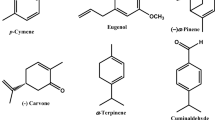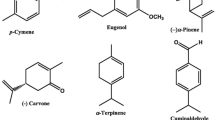Abstract
Phytoecdysteroids are analogs of insect hormones that control various vital functions, in particular, molting and metamorphosis. These phytoecdysteroids form part of the plant’s defenses against insect pests. In the present work, we studied the effect of five phytoecdysteroids (20-hydroxyecdysone, Makisterone A, Ponasterone A, Polypodine B, Ecdysone) on larvae of Tribolium castaneum (Herbst) (Coleoptera: Tenebrionidae). It is the most common pest of stored products. This study aimed to determine if small structural changes between these molecules could change their activity as antifeedants and growth disruptors in insect pests. Initially, we studied their effects on larval feeding behavior using a non-choice test by observing the presence of those larvae on the food pellets. Then we studied their toxicity on the insect development parameters by observing mortality percentages, pupation, and the emergence of adults. Our results indicate that all phytoecdysteroids possess antifeedant properties against T. castaneum larvae. This activity differs depending on the molecule and the concentration used. Compared to the control, 20-hydroxyecdysone exhibited a significant antifeedant activity, while polypodine B showed the lowest effect when incorporated to T. castaneum diet at the highest doses. Phytoecdysteroids caused significant disturbances in the growth and development parameters of T. castaneum, manifested by an inducted mortality, delayed pupation, reduced pupation, and reduced emergence of adults. From the study, we could conclude that the susceptibility of T. castaneum against phytoecdysteroids differs depending on the analog used. The minimal structural differences between these molecules could significantly affect their efficacy against this insect pest.





Similar content being viewed by others
References
Ahmad F, Walter GH, Raghu S (2012) Comparative performance of Tribolium castaneum (Herbst) (Coleoptera: Tenebrionidae) across populations, resource types and structural forms of those resources. J Stored Prod Res 48:73–80. https://doi.org/10.1016/j.jspr.2011.09.005
Ahn YJ, Lee SB, Lee HS, Kim GH, Lee HS (1998) Insecticidal and acaricidal activity of carvacrol and β-thujaplicin derivatives. J Agric Food Chem 46:2629–2632
Ajaha A, Annaz H, Bouayad N, Aarab A, Rharrabe K (2021) Ingestion effect of Makisterone A, a phytoecdysteroid, on development and detoxification enzymes of Tribolium castaneum (Coleoptera: Tenebrionidae). Afr Entomol 29:332–340. https://doi.org/10.4001/003.029.0332
Aly R, Ravid U, Abu-Nassar J, Botnick I, Lebedev G, Gal S, Ziadna H, Achdari G, Smirov E, Meir A, Ghanim M (2011) Biological activity of natural phytoecdysteroids from Ajuga iva against the sweet potato whitefly Bemisia tabaci and the Persea mite Oligonychus perseae. Pest Manag Sci 67:1493–1498. https://doi.org/10.1002/ps.2203
Arnault C, Sláma K (1986) Dietary effects of phytoecdysones in the leek-moth, Acrolepiopsis assectella Zell. (Lepidoptera: Acrolepiidae). J Chem Ecol 12:1979–1986. https://doi.org/10.1007/BF01041947
Balasubramanian R, Selvaraj P, Sahayaraj K (2008) Partial purification and characterization of phytoecdysone from Chrystella parasitica (L.) and screening its pesticidal properties on lepidopteran pests. J Biopestic 1:201–205
Báthori M, Tóth N, Hunyadi A, Márki Á, Zador E (2008) Phytoecdysteroids and anabolic-androgenic steroids structure and effects on humans. Curr Med Chem 15:75–91. https://doi.org/10.2174/092986708783330674
Calabrese EJ, Baldwin LA (2003) The hormetic dose-response model is more common than the threshold model in toxicology. Toxicol Sci 2003(2):246–250. https://doi.org/10.1093/toxsci/71.2.246
Campbell JF, Athanassiou CG, Hagstrum DW, Zhu KY (2022) Tribolium castaneum: a model insect for fundamental and applied research. Annu Rev Entomol 67:347–365
Chen J, Rashid T, Feng G, Feng Y, Zhang A, Grodowitz MJ (2019) Insecticidal activity of methyl benzoate analogs against red imported fire ants, Solenopsis invicta (Hymenoptera: Formicidae). J Econ Entomol 112:691–698. https://doi.org/10.1093/jee/toy360
Daniewski WM, Gumułka M, Przesmycka D, Ptaszyńska K, Błoszyk E, Drożdż B (1995) Sesquiterpenes of Lactarius origin, antifeedant structure-activity relationships. Phytochemistry 38:1161–1168. https://doi.org/10.1016/0031-9422(94)00781-N
De-fu C, Ming-xue S, Wen-fu X (2002) Pesticidal character of phytoecdysteroids from Ajuga multiflora Bunge (Labiatae) on larvae of Cryptorrhynchus lapathi L. (Coleoptera: Curculionidae). J For Res 13:177–182
Delobel A, Tran M (1993) Les Coléoptères des denrées alimentaires entreposées dans les régions chaudes, vol 32. IRD Editions
Desneux N, Decourtye A, Delpuech JM (2007) The sublethal effects of pesticides on beneficial arthropods. Annu Rev Entomol 52:81–106. https://doi.org/10.1146/annurev.ento.52.110405.091440
Dinan L (2001) Phytoecdysteroids: biological aspects. Phytochemistry 57:325–339. https://doi.org/10.1016/s0031-9422(01)00078-4
Dinan L, Mamadalieva NZ, Lafont R (2019) Dietary phytoecdysteroids. Handb Diet Phytochemicals 1–54. https://doi.org/10.1007/978-981-13-1745-3
Downer RG, Laufer H (1983) Endocrinology of insects. AR Liss
Dreier SI, Towers GHN (1988) Activity of ecdysterone in selected plant growth bioassays. J Plant Physiol 132(88):509–512. https://doi.org/10.1016/S0176-1617
Elliott M, Pulman DA, Larkin JP, Casida JE (1992) Insecticidal 1, 3-dithianes. J Agric Food Chem 40:147–151. https://doi.org/10.1021/jf00013a029
Erst AA, Zibareva LN, Filonenko ES (2021) Variation in phytoecdysteroid accumulation in hairy roots of Silene linicola over extended time periods. J Plant Biochem Biotechnol 1–5. https://doi.org/10.5897/JMPR12.059
Gao X, Yu Y, Liu X, Luo X, Wang Y (2021) Efficacy of diatomaceous earth against Tribolium castaneum and Rhyzopertha dominica on stored wheat and its effect on wheat quality. J. Stored Prod. Res 92: 101803. https://doi.org/10.1016/j.jspr.2021.101803
Golovatskaya IF (2004) Effect of ecdysterone on morphological and physiological processes in plants. Russ J Plant Physiol 51:407–413. https://doi.org/10.1023/B:RUPP.0000028689.97402.d5
González-Coloma A, Guadano A, Gutiérrez C, Cabrera R, de la Pena E, de la Fuente G, Reina M (1998) Antifeedant delphinium diterpenoid alkaloids. Structure – activity relationships. J Agric Food Chem 46:286–290. https://doi.org/10.1021/jf970585p
Guo SS, Pang X, Wang Y, Geng ZF, Cao JQ, Liang JY, Deng ZW, Du SS (2020) Chemical constituents isolated from stems of Schisandra chinensis and their antifeedant activity against Tribolium castaneum. Nat Prod Res 34:2595–2601. https://doi.org/10.1080/14786419.2018.1547291
Haddi K, Oliveira EE, Faroni LR, Guedes DC, Miranda NN (2015) Sublethal exposure to clove and cinnamon essential oils induces hormetic-like responses and disturbs behavioral and respiratory responses in Sitophilus zeamais (Coleoptera: Curculionidae). J Econ Entomol 108:2815–2822. https://doi.org/10.1093/jee/tov255
Haridasan P, Gokuldas M, Ajaykumar AP (2017) Antifeedant effects of Vitex negundo L. leaf extracts on the stored product pest, Tribolium castaneum H. (coleoptera: tenebrionidae). Int J Pharm Pharm Sci 9:17–22. https://doi.org/10.22159/ijpps.2017v9i3.15600
Ishikawa S, Hirao T, Arai N (1969) Chemosensory basis of hostplant selection in the silkworm. Entomol Exp Appl 12:544–554. https://doi.org/10.1111/j.1570-7458.1969.tb02552.x
Isman MB, Machial CM (2006) Pesticides based on plant essential oils: from traditional practice to commercialization. Phytochemicals in pest control. Springer, Dordrecht, pp 29–44
Jurenka R, Russell K, O’Neal M (2017) Phytoecdysteroids as antifeedants towards several beetles that include polyphagous and monophagous feeding guilds. Pest Manage Sci 73:1633–1637. https://doi.org/10.1002/ps.4500
Koolman J (1982) Ecdysone metabolism. Insect Biochem 12:225–250
Lafont R (1997) Ecdysteroids and related molecules in animals and plants. Arch Insect Biochem Physiol 35:3–20. https://doi.org/10.1002/(SICI)1520-6327(1997)35:1/2<3:AID-ARCH2>3.0.CO;2-X
Lee HK, Lee HS (2016) Toxicities of active constituent isolated from Thymus vulgaris flowers and its structural derivatives against Tribolium castaneum (Herbst). Appl Biol Chem 59:821–826. https://doi.org/10.1007/s13765-016-0230-3
Luthria DL, Ramakrishnan V, Banerji A (1993) Insect antifeedant activity of furochromones: structure-activity relationships. J Nat Prod 56:671–675. https://doi.org/10.1021/np50095a002
Machackova I, Vagner MARTIN, Slama KAREL (1995) Comparison between the effects of 20-hydroxyecdysone and phytohormones on growth and development in plants. Eur J Entomol 92:309–309
Marion-Poll F, Descoins C (2002) Taste detection of phytoecdysteroids in larvae of Bombyx mori, Spodoptera littoralis, and Ostrinia nubilalis. J Insect Physiol 48:467–476. https://doi.org/10.1016/S0022-1910(02)00068 – 9
Melé E, Messeguer J, Gabarra R, Tomas J, Coll J, Camps F (1992) In vitro bioassay for the effect of Ajuga reptans phytoecdysteroids on Trialeurodes vaporariorum larval development. Entomol Exp Appl 62:163–168. https://doi.org/10.1111/j.1570-7458.1992.tb00656.x
Nenaah GE (2014) Toxic and antifeedant activities of prenylated flavonoids isolated from Tephrosia apollinea L. against three major coleopteran pests of stored grains with reference to their structure—relationship. Nat Prod Res 28:2245–2252. https://doi.org/10.1080/14786419.2014.932788
Peterson SC, Hanson FE, Warthen JD (1993) Deterrence coding by a larval Manduca chemosensory neuron mediating rejection of a non-host plant. Canna generalis L Physiol Entomol 18:285–295. https://doi.org/10.1111/j.1365-3032.1993.tb00601.x
Prasuna AL, Osmani Z (1983) Inhibitory effects of ecdysterone on the adult emergence of Achoea janataactivity L. Sci Cult Res 48:73–80. https://doi.org/10.1016/j.jspr.2011.09.005
Rharrabe K, Alla S, Maria A, Sayah F, Lafont R (2007) Diversity of detoxification pathways of ingested ecdysteroids among phytophagous insects. Arch Insect Biochem: Published in Collaboration with the Entomological Society of America 65(2):65–73
Rharrabe K, Sayah F, Lafont R (2010) Dietary effects of four phytoecdysteroids on growth and development of the indian meal moth, Plodia interpunctella. J Insect Sci 10:13. https://doi.org/10.1673/031.010.1301
Rharrabe K, Sayah F, Marion-Poll F (2011) Gustatory perception of phytoecdysteroids in Plodia interpunctella larvae. Entomol Exp Appl 138:33–39. https://doi.org/10.1111/j.1570-7458.2010.01068.x
Robbins WE, Kaplanis JN, Thompson MJ, Shortino TJ, Joyner SC (1970) Ecdysones and synthetic analogs: molting hormone activity and inhibitive effects on insect growth, metamorphosis, and reproduction. Steroids 16:105–125. https://doi.org/10.1016/S0039-128X(70)80100-3
Rodríguez A, Beato M, Usseglio VL, Camina J, Zygadlo JA, Dambolena JS, Zunino MP (2022) Phenolic compounds as controllers of Sitophilus zeamais: a look at the structure-activity relationship. J Stored Prod Res 99:102038. https://doi.org/10.1016/j.jspr.2022.102038
Rosmiati R, Lante S, Suryati E (2017) The effect of phytoecdysteroid of Cycas revolua, Portulaca oleracea, and Morus sp. on molting period, growth and survival rate of tiger shrimp, Penaeus monodon. Indones Aquac J 11: 69–74. https://doi.org/10.15578/iaj.11.2.2016.69-74
Schmelz EA, Grebenok RJ, Ohnmeiss TE, Bowers WS (2002) Interactions between Spinacia oleracea and Bradysia impatiens: a role for phytoecdysteroids. Arch Insect Biochem Physiol 51:204–221. https://doi.org/10.1002/arch.10062
Singh P, Russell GB, Fredericksen S (1982) The dietary effects of some ecdysteroids on the development of housefly. Entomol Exp Appl 32:7–12. https://doi.org/10.1111/j.1570-7458.1982.tb03174.x
Soriano IR, Riley IT, Potter MJ, Bowers WS (2004) Phytoecdysteroids: a novel defense against plant-parasitic nematodes. J Chem Ecol 30:1885–1899. https://doi.org/10.1023/B:JOEC.0000045584.56515.11
Tanaka Y, Takeda S (1993) Ecdysone and 20-hydroxyecdysone supplements to the diet affect larval development in the silkworm, Bombyx mori differently. J Insect Physiol 39:805–809. https://doi.org/10.1016/0022-1910(93)90111-4
Tanaka Y, Asaoka K, Takeda S (1994) Different feeding and gustatory responses to ecdysone and 20-hydroxyecdysone by larvae of the silkworm, Bombyx mori. J Chem Ecol 20:125–133. https://doi.org/10.1007/BF02065995
Uneme H, Iwanaga K, Higuchi N, Kando Y, Okauchi T, Akayama A, Minamida I (1999) Synthesis and insecticidal activity of nitroguanidine derivatives. Pestic Sci 55:202–205. https://doi.org/10.1002/(SICI)1096-9063(199902)55:2<202:AID-PS869>3.0.CO;2-G
van Loon JJ, Schoonhoven LM (1999) Specialist deterrent chemoreceptors enable Pieris caterpillars to discriminate between chemically different deterrents. In Proceedings of the 10th International Symposium on Insect-Plant Relationships Springer, Dordrecht, pp 29–35. https://doi.org/10.1007/978-94-017-1890-5_4
Xavier GSA, Selvaraj P, John N (2016) Impact of phytoecdysone fractions of the ferns Cyclosorous interruptus, Christella dentata and Nephrolepis cordifolia on the biology of Spodoptera litura (Fab.). J. Biopestic. https://doi.org/9:125.10.57182/jbiopestic.9.2.125-134
Xin-nian ZENG, Jian‐feng FANG, Shan‐xue ZHANG, Jian‐yong HAN (2001) Effects of cyasterone on growth and development of diamondback moth, Plutella xylostella (L). J Insect Sci 8:233–239. https://doi.org/10.1111/j.1744-7917.2001.tb00447.x
Yusupova UY, Ramazonov NS, Syrov VN, Sagdullaev SS (2022) Phytoecdysteroids. Springer, Singapore, pp 1–48
Zolotar RM, Bykhovets AI, Kashkan ZN, Chernov YG, Kovganko NV (2002) Structure-activity relationship for insecticidal steroids. VI. 5, 6-Disubstituted β-sitosterols. Chem Nat Compd 38:167–170. https://doi.org/10.1023/A:1019644115900
Acknowledgements
The authors are grateful to René Lafont (Sorbonne University, Paris. France) for his kind gift of the Phytoecdysteroids used in this study. We are also grateful to Nasreddine Hammani for the English improvement and corrections made to the manuscript.
Author information
Authors and Affiliations
Corresponding authors
Ethics declarations
Conflicts of interest
The authors declare that they have no conflict(s) of interest.
Additional information
Publisher’s Note
Springer Nature remains neutral with regard to jurisdictional claims in published maps and institutional affiliations.
Rights and permissions
Springer Nature or its licensor (e.g. a society or other partner) holds exclusive rights to this article under a publishing agreement with the author(s) or other rightsholder(s); author self-archiving of the accepted manuscript version of this article is solely governed by the terms of such publishing agreement and applicable law.
About this article
Cite this article
Ajaha, A., Annaz, H., Bouayad, N. et al. Antifeedant and growth disruption activities of five phytoecdysteroids in the red flour beetle Tribolium castaneum: structure-activity relationship. Int J Trop Insect Sci 43, 1179–1188 (2023). https://doi.org/10.1007/s42690-023-01014-6
Received:
Accepted:
Published:
Issue Date:
DOI: https://doi.org/10.1007/s42690-023-01014-6




